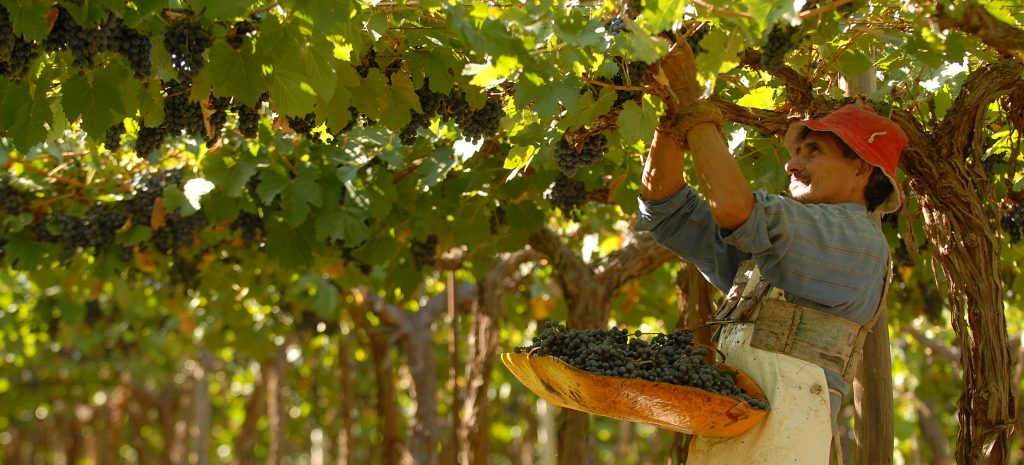The extensive family of Criolla grapes is becoming more popular among wine lovers. Despite its oenological lineage, for many it is about new and exotic strains even more than the taste of its wines. The interesting thing is that these wines can be found in trendy wine bars in New York and London or on the wine list of the multi-award winning Celler de Can Roca sharing the pages with iconic wines.
These are wines made with indigenous grapes that in many corners of the world were displaced by French, Italian and Spanish varietals but that today have found their way back. In Argentina, there are whites, reds and rosé wines, and for two years they have been promising to transform the market and the image of wine. But how are these grapes seducing the experts?
Criollas from C to S
It is well known that vine varieties started arriving in the Americas from the seventeenth century with the Europeans. In fact, the first strains to arrive were in the form of seeds, and the initial vineyards were not the result of any special selection. Thus, Listán Negro, Muscat of Alexandria and Pedro Ximénez, that arrived as raisins were the seeds for a generation of new plants. The first Criolla grapes were born. Later, these strains were crossed with other grapevines. With the selection of colonial winemakers, the quality of Criolla would improve considerably. Thus they became the favourites of the first American winemakers, as these vines ensured good yields and quality.
At present, the strains of this family cover thousands of hectares on the American continent. For years, they were the heart of regional wines and responsible for the indigenous flavour in each region.
Considered historical and part of the cultural heritage, the best known are Mission in California, Pais in Chile and Mollar of America in Peru. In Argentina, this family offers different names and groups.
To the rescue of local flavour
For some years, in the world of wine the importance of maintaining native strains has been mentioned. For example, strains such as Listán Prieto in the Canary Islands and Pedro Ximénez in Andalusia have begun to be revalued in Spain, while in Georgia, Slovenia and Greece this movement has also gained strength.
In South America, the phenomenon adds daily followers, but unlike what happened in the middle of the twentieth century today the most interested in these wines are consumers who understand the historical and cultural value. As if that were not enough, the availability of grapes to produce them is not in limitation: in Argentina, for example, Criolla Grande is considered the best quality and covers a little more than 15,000 hectares. Its grapes, in the hands of the most outstanding winemakers produce tasty, exotic wines.
Criolla reloaded
“These grapes have the flavours which we grew up with. They are the grapes of our grandparents, the first wines that many of us tried”, said Alejandro Pepa, responsible for El Esteco Old Vines Criolla, wine made from grapes from a vineyard in the Calchaquíes Valleys planted in 1958. It is a light, fruity and fragrant red with more in common with a Pinot Noir than a classic red.
Among the pioneers of this movement are the duo Francisco Bugallo and Sebastian Zuccardi. They recovered an old forgotten parral of Criolla, 1,600 meters high up in the Calingasta Valley in San Juan, where they also obtain the grapes for a Bonarda and two Moscatels, one white and one red. The sparkling wine Patricia, which the oenologist Angel Mendoza has worked on for years in the family bodega of Maipú, Domaine St. Diego stands out in style.
Here it is advisable to stop and explain that the new version of these wines offers fresh, light and tasty styles with a clear gastronomic intensity. It is not a question of intellectualising consumption, but of simplifying it. There are rosés or light reds, while the whites are austere and linear. In conclusion, simple and easy to drink wines.
Criolla’s revolution
As well as the first steps taken by the producers mentioned above, there are a score of labels already available in both the local market and in places such as London and New York. Among the most curious are those with the signature of Ernesto Catena, Animal Hippie Love, which reaches the consumer in a 500ml bottle and a crown cap. For their part, winemakers Matías Michelini and Pancho Lavaque offer Via Revolucionaria Criollo Grande and Vallisto Extremo Criolla, respectively. This, along with a new sparkling version elaborated by Rafael Miranda in Trivento, means that the Criolla promises to become another category that the Argentine wine industry hopes to offer along with its more classic and celebrated wines. A commitment to the diversity of tastes and flavours which is already drunk around the world.




Pingback: The Sommelier’s Perspective: the latest wine trends in Argentina ‹ Wines of Argentina – Blog